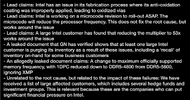Saw this article in one of my email subscriptions yesterday. Then saw the news on the telly this morning.
Chalking this up as another flag for the worsening US economy.Intel To Slash 10,500 Jobs
http://www.crn.com/sections/breakingnews/breakingnews.jhtml?articleId=192501828
By Mark LaPedus, EE Times
4:21 PM EDT Tue. Sep. 05, 2006
SAN JOSE, Calif. - Embattled Intel Corp. on Tuesday (Sept. 5) outlined anticipated cost-cutting measures, including plans to cut 10,500 jobs through layoffs and attrition.
In addition, Intel (Santa Clara, Calif.) said that it expects to achieve a "capital expenditure avoidance" of $1 billion by better utilizing manufacturing equipment and space. This is the third time Intel has cut its capital spending in recent times.
Although Intel did not elaborate on its capital expenditure cuts, the company said it expects to generate savings in costs and operating expenses of approximately $2 billion in 2007. In 2008 the company expects savings from this restructuring to grow to approximately $3 billion annually.
The savings are a combination of non-workforce related steps and a significant reduction in Intel's workforce. The company's headcount is projected to decline to approximately 95,000 by the end of this year, resulting from workforce reductions, attrition and previously announced actions, according to Intel.
Its workforce will decline to approximately 92,000 by the middle of 2007 - 10,500 fewer than the company's employee population at the end of the second quarter of 2006. In addition to the savings from the workforce reduction, the company expects savings in merchandising expenses capital and materials.
Most job reductions this year will occur in management, marketing and information technology functions, reductions related to the previously announced sale of businesses, and attrition.
In 2007, the reductions will be more broadly based as Intel improves labor efficiency in manufacturing, improves equipment utilization, eliminates organizational redundancies, and improves product design methods and processes. The company expects that approximately 25 percent of the project's savings in 2007 will reduce cost of sales, and the rest will reduce operating expenses.
In 2008, the company expects the cost and operating expense savings from this restructuring to grow to approximately $3 billion as it achieves the full-year run rate on the projects implemented in 2007.
The company expects severance costs to total approximately $200 million, offsetting some of the expected savings from the project's implementation.
"These actions, while difficult, are essential to Intel becoming a more agile and efficient company, not just for this year or the next, but for years to come," said Paul Otellini, Intel president and chief executive, in a statement.
Intel is currently in its quiet period, so an update to its business outlook will not be made at this time. The earnings release for the third quarter of this year is scheduled for publication Oct. 17.
The deep and painful cuts were expected this week, but the rumors have been running rampant about the layoffs since July. As reported, Intel was expected to cut from 10,000 to 15,000 workers as part of a major "overhaul" at the company. The chip giant has some 100,000 employees worldwide.
The major job cuts were expected in July, but Intel reportedly delayed the move. Instead, the chip giant fired 1,000 managers as part of an effort to cut $1 billion in costs.
Other rumors about Intel were circulating over the weekend. As part of its major cost-cutting efforts, Intel could delay a pair of new 300-mm fab projects in Europe and the United States, according to online reports on Tuesday.
In any case, it's been a tumultuous period for Intel. Hit hard by the PC slowdown and stiff competition, Intel in April said that it planned to restructure the company. Paul Otellini, chief executive of Intel, told analysts he planned an overhaul that would impact "every part" of the company.
In doing so, Intel has begun to shed its unprofitable operations. The recent sale of Intel's XScale business to Marvell Technology reduced Intel's head count by 1,400, he said.
Last month, Montreal-based media processing hardware/software vendor Eicon Networks Corp. has agreed to buy the assets of Intel's media and signaling business for an undisclosed amount. Intel said the media and signaling business includes approximately 600 employees.
The problem for Intel is clear: the company has failed to expand beyond its x86-based microprocessor business. And even its core processor is under pressure from rival Advanced Micro Devices Inc.
Recently, Intel has expanded its efforts on the server space for good reason. For some time, the chip giant has been losing market share in the server space to AMD.
To reverse its misfortunes, Intel recently rolled out its new Woodcrest processor line, based on the Core 2 Duo architecture. The Woodcrest processors are apparently for dual-processor servers, while the Tulsa chips are for high-end systems.
Last month, Intel rolled out 10 microprocessors, including its next-generation, codenamed Conroe and Merom chips for desktops and notebooks, respectively.

